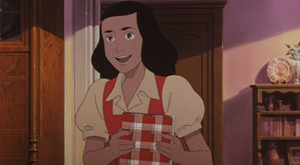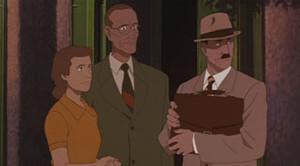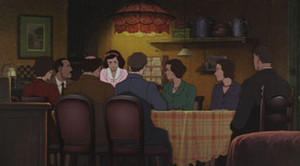Pile of Shame
The Diary of Anne Frank
by Justin Sevakis,
When I was in middle school, my class went on a field trip to a local theater to see a play called The Last Days of Mr. Lincoln. I was really looking forward to this trip. After all, I loved shows of all kinds, be they plays or movies, and any trip outside of school to break up the monotony of youth was one I welcomed. But once the show started, my excitement was extinguished by the cold, harsh winds of reality. The play, a community theater fiasco that expected us to know obscure historical figures, follow and care about their drama, and yet didn't even bother casting someone to play Abraham Lincoln (who was represented occasionally by a scratchy audio recording), was unwatchable. During the intermission, the kids all mumbled amongst themselves vague indications of pain and boredom. I spent the second act trying to will myself to sleep.
Kids, especially the ones who are patient with entertainment as I was, are a pretty easy-to-please crowd. But that day, upon sitting in those seats, I learned a horrifying lesson: the absolute worst, poorest and most soul-crushingly boring specimens of entertainment will always be performed in the name of education.
That experience came back to me while I was watching the anime movie adaptation of The Diary of Anne Frank.

The Diary of Anne Frank
 For those unfamiliar (or those who, like me, were not forced to read the book in school), Anne Frank was a Jewish 13-year-old living in Amsterdam during the Nazi occupation. With more and more Jews being taken into concentration camps, Anne's father arranged for the family to hide in a hidden apartment above the office he once worked in, where they stayed for two years (sharing the close quarters with another family and a single man). The family was eventually betrayed, and all were taken to the camps, where Anne later died of illness. But she left behind her diary, which accounted the entire ordeal in intimate detail. Only her father survived the war, and upon discovering the diary (and with it, her dream of being a published author), he submitted it to publishers. In the decades since, it's become a seminal work, and part of the curriculum of many history and literature classes in schools around the world.
For those unfamiliar (or those who, like me, were not forced to read the book in school), Anne Frank was a Jewish 13-year-old living in Amsterdam during the Nazi occupation. With more and more Jews being taken into concentration camps, Anne's father arranged for the family to hide in a hidden apartment above the office he once worked in, where they stayed for two years (sharing the close quarters with another family and a single man). The family was eventually betrayed, and all were taken to the camps, where Anne later died of illness. But she left behind her diary, which accounted the entire ordeal in intimate detail. Only her father survived the war, and upon discovering the diary (and with it, her dream of being a published author), he submitted it to publishers. In the decades since, it's become a seminal work, and part of the curriculum of many history and literature classes in schools around the world.
Given Japan's love of child- and teen-tragedy stories, it's not a shock that when The Diary of Anne Frank was first published, the Japanese translation sold like hotcakes. Of the several play and feature film adaptations of the book that are out there, Japan boasts two anime adaptations. These include a TV special by Nippon Animation from the late 70s, and this feature film produced by Madhouse in 1995. I had heard very little about this film, but given the subject matter, I wasn't expecting it to be a huge hit on the convention circuit.
It is not very good. In fact, it might be one of the worst world literature anime ever made.
 Some of the problems with the film are immediately obvious at first glance. The character design (by Katsuyuki Kubo) tries for realism, but overshoots its target and ends up looking like bad caricatures from a theme park sketch artist. Anne is no longer the cute girl we've seen in photos, but somewhat mannish looking; it's impossible to even look at her without remarking, "holy god, look at those eyebrows!" Indeed, Anne (and everyone else in the film) are rendered with such attention to realism that there's nothing left for the animators to work with.
Some of the problems with the film are immediately obvious at first glance. The character design (by Katsuyuki Kubo) tries for realism, but overshoots its target and ends up looking like bad caricatures from a theme park sketch artist. Anne is no longer the cute girl we've seen in photos, but somewhat mannish looking; it's impossible to even look at her without remarking, "holy god, look at those eyebrows!" Indeed, Anne (and everyone else in the film) are rendered with such attention to realism that there's nothing left for the animators to work with.
So not only does Anne look like that, but her face barely moves at all. In fact, everyone's face seems frozen in place, as if they were wearing a creepy rubber mask. Truthfully, this might be more of a problem if we ever saw anyone in close-up, but that never occurs.
Think about that for a minute. This is a film about eight people trapped in insanely close quarters for two years. And we never see a close-up -- and barely ever any medium shots. In fact, nearly the entire film is shot in stationary, minutes-long wide shots. The camera is never allowed any intimacy with the characters, maintaining a huge amount of distance, as if we were watching a melodramatic play. I can sort of understand wanting to capture some of that mood in film form, but some choices are completely baffling: when Anne's family leave their apartment for the last time, we see it in a single, wordless, long overhead shot of the building -- one that lasts, unbroken, for about a minute! It's excruciating!
 If the cinematography makes one think of an intensely bad play, the dialogue does not help. We sit still from far away, watching characters speak in oddly informative arguments, and then overact, all without moving their faces much. Entire scenes play out from a single, unmoving camera angle, with not a single cut. When there is no interpersonal action to be had, Anne moves slowly, maddeningly slowly, in every possible interaction with the world around her, accompanied at times by the funerary, droning score of British minimalist composer Michael Nyman.
If the cinematography makes one think of an intensely bad play, the dialogue does not help. We sit still from far away, watching characters speak in oddly informative arguments, and then overact, all without moving their faces much. Entire scenes play out from a single, unmoving camera angle, with not a single cut. When there is no interpersonal action to be had, Anne moves slowly, maddeningly slowly, in every possible interaction with the world around her, accompanied at times by the funerary, droning score of British minimalist composer Michael Nyman.
There are films that can get away with this sort of pacing, this somber feel of nothing-happening. They do it by giving you things to think about, small details to process, moods to sit in. The Diary of Anne Frank does none of these things; it can weave no spell with its lazy camera and its expressionless faces. It is interminable.
I can find almost no information about this film online, in English or Japanese. I have no idea if it was successful or not. At pencil test stage, someone in charge -- either director Akinori Nagaoka (whose other work is mostly very young kids' shows like Anpanman), or the producer, or maybe its famed storyboardists Morio Asaka, Rintarō or Toshio Hirata -- SHOULD have shouted, "STOP! Whatever you are doing, it is unengaging, poor filmmaking and we should stop right now."
 But to the contraray, clearly a lot of love was put into the making of this film. The backgrounds are exquisite, featuring some work by Ghibli stalwart Nizo Yamamoto. The animation itself sticks very close to model and shows body language in microscopic detail. But the film just cannot engage. Even a story as powerful as Anne Frank's cannot overcome truly odious filmmaking and weird directorial choices that just don't work.
But to the contraray, clearly a lot of love was put into the making of this film. The backgrounds are exquisite, featuring some work by Ghibli stalwart Nizo Yamamoto. The animation itself sticks very close to model and shows body language in microscopic detail. But the film just cannot engage. Even a story as powerful as Anne Frank's cannot overcome truly odious filmmaking and weird directorial choices that just don't work.
A few years after the film was made, a consortium of French companies tried to salvage the film by recutting and adapting it heavily. About twenty minutes were excised, the minimalist musical score was replaced with a somewhat overwrought but at least emotive orchestral soundtrack, and a whole lot of dialogue was added. It helps a little, but the problems with the deadpan cinematography and stage direction are so prominent that the visuals end up clashing strangely with overly earnest voice acting and mawkish music. While the end result, entitled "Le Journal d'Anne Frank," is more entertaining, watching it is still an exercise in patience, with little in the way of dramatic payoff. But it can be watched, if nothing else.
It's not that this material can't be made into a compelling piece of cinema. The 1959 American adaptation is considered a classic (and indeed, won 3 Oscars that year). The story is still haunting and tragic -- the book is so widely known for a reason. But I can't think of a worse way to experience the story than watching this film.
|
Japanese Name: アンネの日記 (ANNU no Nikki) Media Type: Movie Length: 103 min. Vintage: 1995 Genres: Historic, period, drama, biography, world literature Availability (Japan): The Japanese DVD is in print, and cheap even by American standards. Availability (English): Only English subtitles on the French DVD of the French recut. |
discuss this in the forum (36 posts) |
this article has been modified since it was originally posted; see change history